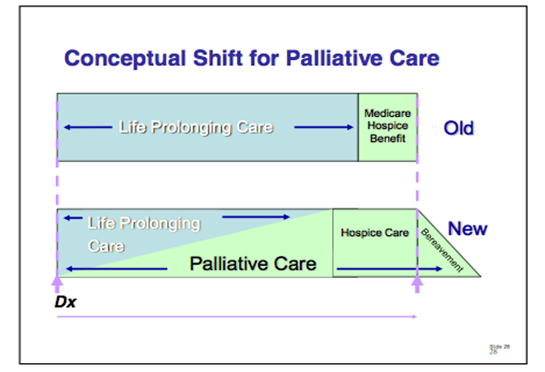Returning to my review of palliation and how it can lower cost and improve care for patients with serious illness. Again my thanks to Diane Meier, MD, PACP, Director, Center to Advance Palliative Care at the Mt. Sinai School of Medicine in New York for her work in this area.
To provide some context:
- -95% of all healthcare spending is for the chronically ill;
- -64% of all Medicare spending goes to 10% of beneficiaries with 5 or more chronic conditions; and,
- -The quality of care is poor in relation to the spending
Definition:
Palliative care is specialized medical care for people with serious illnesses. This type of care is focused on providing patients with relief from the symptoms, pain, and stress of a serious illness – whatever the diagnosis.
The goal is to improve quality of life for both the patient and the family. Palliative care is provided by a team of doctors, nurses, and other specialists who work with a patient’s other doctors to provide an extra layer of support. Palliative care is appropriate at any age and at any stage in a serious illness, and can be provided together with curative treatment.
What palliative care addresses:
- -Physical, emotional, and spiritual distress
- -Patient-family-professional communications about achievable goals for care and the decision-making that follows.
- -Coordinated, communicated, continuity of care and support for the practical needs of both patients and families across settings.
The graphic to the right conceptualizes the shift toward palliation. It not only visualizes what the shift would look like when compared to life 
Life prolonging care began immediately with evidence-based medicine. There were early and significant reduction in tumor size. Side effects were well manged and life was prolonged. Quality of life was always in the forefront of any discussion and decisions. Let me remake this point, we were receiving palliative care. It prolonged life with quality.
“Palliative care is not end of life care nor is it hospice.”
In hindsight we were not told we were receiving palliative care but we were. For all intents and purposes, the care we were receiving did feel curative and life prolonging.
Dr. Meier states the following as reasons palliation care improves value:
Quality Improves
- -Improves patient quality/length of life
- -Reduced pain, depression and other symptoms
- -Some studies demonstrate it prolongs life
- -Finally, it improves family satisfaction and well-being
Costs are reduced
- -Reduces resource utilization and costs in every setting studied
- -It does this for the sickest of the 5 to 10% of Medicare and Medicaid beneficiaries which drive over half of tax-payer supported healthcare costs
Moving to Active Palliative Care
Donna’s decline during the last few months was steep though we remained confident that current standards of care would maintain quality of life. The major condition that reduced quality of life was hypertrophic pulmonary osteoarthropathy (HPO). This is directly related to the tumors and the reality was that after three rounds of chemo there was no evidence that another different combination would shrink the tumors to manage the HPO. Drug of choice was NSAIDS. She was now moving from the area of prolonged life to active palliative care. This is when our oncologist had the discussion about goals and palliation.
In a prospective multicenter study of 332 cancer patients:
Family recall of the occurrence of prognostic/goals conversation was associated with:
- -Better quality of life
- -Less Hospital/ICU, lower costs
- -Lower risk of complicated grief plus bereavement among family caregivers.
Reference: Zhang et al Arch Int Med 2009, 169:480-8Wright et al JAMA 2008:300:1665-73
We had this discussion while in the hospital for a thoracocentesis. I remember this and how well this discussion was managed (no orchestrated) by our oncologist along with a social worker, residents, and nursing staff. We were being offered palliative care at home. There was the shock that we never had time to fully understand since within a couple of days Donna was moved to the hospice unit. The full significance and definition of palliation was put in place. There was an entire team of professionals who attended to both Donna’s care and mine. We could not have asked for better support at this horrific moment in both our lives. We were guided in our decisions by a staff that put our needs first. It was not patient and family is was patient-family. A single unit of care.
There are consequences of late referral to palliative care. Serious adverse outcomes for bereaved caregivers compared to care at home with hospice:
- -Care in ICU is associated with 5X family risk of Post Traumatic Stress Disorder
- -Care in hospital associated with 8.8X family risk of prolonged grief disorder
Reference: Wright A et al. Place of death: Correlation with quality of life of patient with cancer and predictors of bereaved caregivers mental health JCO 2010: Sept 13
Seven months following Donna’s passing the support that was present during this period remains in place and the care given to Donna and support I received is my anchor; it is the guidepost I use to navigate my way back into life. This is palliative care. Neither one of us were left without care and support.
Palliative care improves quality in office settings too.
Randomized trials compared standard of care with palliative care co-managed from diagnosis versus control group receiving standard care only. They found that the experimental group:
- -Improved quality of life
- -Reduced major depression
- -Reduced aggressiveness (less chemo< 14d before death, more likely to get hospice, less likely to be hospitalized in last month)
- -Improved survival (11.6 mos. Vs. 8.9 mos. P<0.02)
Reference: Ternel et al Early palliative care for patients with Non-small-cell lung cancer NEJM 2010:363:733-42
“Palliation worked. It made a difference. It reduced cost. It improved quality of life and continues to help me.”
At the Center to Advance Palliative Care and the National Palliative Care Research Center web site there is A State-by State Report Card on Access to Palliative Care in our Nations Hospitals.
See where your state stands. See what can be done to improve your state’s grade. If you or a loved one has a serious illness do not be afraid of the word palliation or palliative care. Ask about it. Look for it. Demand it for you and for America. We all deserve to receive the care Donna and I experienced. Terminal illnesses can be faced with dignity and hope.
About the author: Mark tells his story here on Occupy Healthcare and on Twitter.
